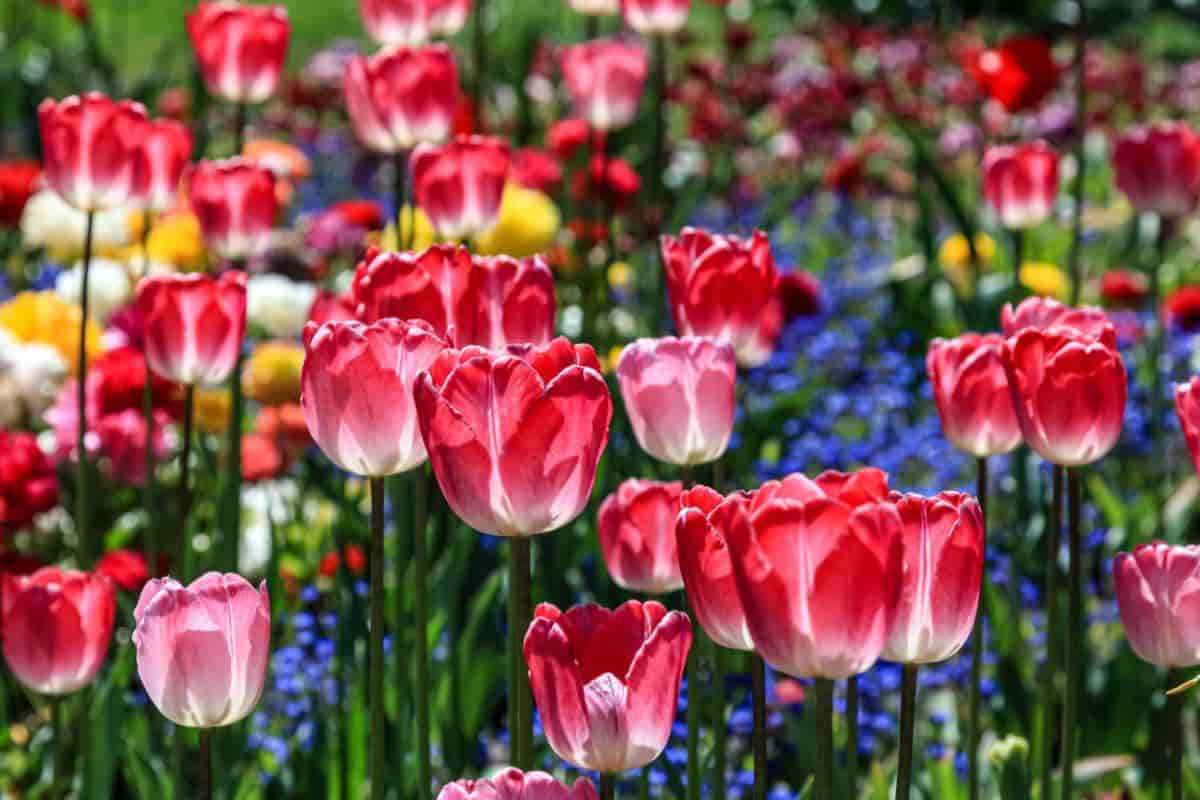Spring and tulips are nearly synonymous. In-home gardens throughout the country, just as here at Kingwood Center in Mansfield, Ohio, where over 100,000 bulbs are planted each fall, many different kinds of tulips give an extended bloom season, as long as six weeks.
For example, it is possible to start with the early-flowering kaufmanniana hybrids, such as Cesar Franck, Fritz Kreisler, Shakespeare, and Vivaldi, which bloom while the landscape is still bare.

These are low-growing and, when wide open, look like creamy white and golden stars scattered over the ground.
Kaufmannianas can also be planted in small groups where their jewel-like quality may be admired at close range. A few groups of a half dozen by the doorway will be a cheerful welcome to all comers.
Tulipa Praestans Fusilier
Before the earliest species of tulips and kaufmannianas are finished flowering, a peer of tulip dom to blare forth in bright orange-scarlet is Fusilier (Tulipa praestans fusilier).
The flower is only the size of a large acorn, but three to five appear on each stem. Planted among the gold daffodils of Lord Wellington, Carlton, and King Alfred, its brilliance is dazzling.
It also combines the creamy double daffodil Cheerfulness and azure blue grape hyacinths.
Fusilier is attractive with large-flowered hyacinths, too, particularly the pale blue Myosotis and the dark purple Duke of Westminster.
Try Fusilier with hyacinth Argentine Arendsen or Queen of Whites for a clean, crisp scarlet and white combination. Despite its small stature, this tulip puts on a great show.
Giant Red Emperor
Along with daffodils, the giant Red Emperor and many of the other fosteriana hybrids bloom at this time.
Red Emperor has gained rapid popularity in recent years, and even the newest homeowners have managed to string a dozen or two bulbs across the front of the house.
Instead of this long, weak line, bring them together into a compact group by the doorway, where they will give a strong color impact.
Scattered about, they are weak excuses for not being more, but in clusters, they are superb.
Newer Fosteriana Hybrids
Available also are the newer fosteriana hybrids, including Cantate, noted for its brilliant vermilion flowers and shiny leaves.
Purissima is a pure white fosteriana hybrid, in shape, size, and earliness, much like Red Emperor. Czardas combines a brilliant yellow base with an orange-scarlet flower.
Singles and Doubles
The tulip season itself starts with the early singles and the early doubles. If only a few early doubles are used in the garden, they produce a strong effect with their short, compact habit and wide-open blooms.
Goya is a particularly rich scarlet-tinged-with-gold variety, which lives up to its name.
Murillo Maxima is a delicate, almost white, pink Peach Blossom, a deeper rose-pink. Both combine well. Aga Khan, a rich gold that turns orange as it ages, is typical of the vivid colors of the early doubles.
The early singles are brilliant, too, particularly the yellow, gold, and orange range. Golden Mascot, Sunburst, and the crimson and yellow Prince Carnival are very gay.
General de Wet, buff-yellow with delicate orange streaking, is an almost unbelievable color because it combines well with other hues.
Bel Ami, a bright rose, has a clean white base, while Van der Neer is one of the most intense magenta-purples of tulips.
Cottage Tulips
Next to come into bloom are the cottage tulips. This group, characterized by oval-shaped flowers, also refined and graceful lily-flowered varieties in-chides.
Earliest to bloom is an intense burnt-orange dazzler called Stanislaus, with stems and leaves overlaid with a purple-bronze cast.
As delicate as Stanislaus is bold is lily-flowered Astor, a tall, creamy pink-apricot. Bond Street is a more recent cottage tulip, first a clear yellow and later a bright yet soft orange.
One of the most outstanding cottage tulips is Rosy Wings, an indescribable blend of rose, peach, and pink.
Large flowers, a graceful urn shape at their peak, open early and last long. Incomparable combines light red Advance, black Queen of Night, lilac-purple Pandion, and Rosy Wings.
Sebastian, one of the best yellows, is a full-bodied golden yellow. Golden Duchess is deep primrose, and Golden Harvest is a clear lemon.
A new wonder of the tulip world is Palestrina, classified as a cottage, yet large enough to suggest the possibility of fosteriana influence.
In color, it resembles Rosy Wings on the inside, with soft lavender on the outer surface. However, the large flowers do not seem to last as long as Rosy Wings.
Other worthwhile cottages and lily-flowered tulips include:
- Zomerschoon, yellow, with a feathered red edge
- White City
- Princess Margaret Rose, yellow and red blend aging to red
- Northern Queen, white-edged rosy pink
- Mrs. John Scheepers, yellow
- Lilac Time
- Smiling Queen, pink
While cottage tulips are somewhat earlier than the late-season breeders, darwins, and triumphs, they generally overlap.
A few, such as Stanislaus, are very early, while sonic darwins are very late, but these are in the minority. It is impossible to separate these according to blooming time and to tell some apart based on form or color.
Tulip’s Main Season of Bloom
The main season of tulip bloom belongs to the triumphs, breeders, and darwins, the aristocrats. These are the neatly sculptured, long-stemmed, stately varieties, with a practically limitless color range.
Some are brilliant (Paul Richter), some soft and subtle (Tantalus), some dark and rich (Queen of Night), and some clear, pure white (Glacier).
A few pleasant combinations include:
- Nobel and Pride of Zwanenburg, soft red and pink
- Niphetos and Queen of Night, ivory and black
- Smiling Queen and New Orleans, pink and burgundy
- New Orleans and Greuze, burgundy, and deep purple
- Orange Delight and Fascinating, soft orange and soft yellow
- Orange Wonder and Reliance, bright bronze orange, and dark silvery lilac
- Indian Chief and Glacier, chestnut brown and white
- The City of Haarlem and Queen of Bartigon, deep blood red and clean salmon pink
- Bruno Walter and Ankara, brownish-orange and deep primrose yellow
Parrot Tulips
In sharp contrast to the stateliness of the Darwin types, the parrot tulips are shaggy and informal.
Black Parrot is the same color as Queen of Night, and the two can be planted together for a one-color, two-textured effect.
The yellow Sunshine parrot and Darwin Sunkist go together similarly.
Others include:
- Wonder, cherry red
- Blue Parrot, lavender
- FireBird, scarlet
Peony-Flowered Tulips
The climax of the tulip season is reached with the late doubles. These are often called peony-flowered tulips since they resemble peonies.
Large, durable, and long-lasting as cut flowers, a favorite variety is the deep mahogany-red Uncle Toni, which combines well with nearly every color, except possibly, some oranges.
At Kingwood, we interplanted it with parrot Sunkist, Symphonia, Livingston, and Eros, cherry red, cardinal, and rose varieties, producing a varied deep pink pattern.
The crisp whiteness of Mount Tacoma is emphasized when used with Uncle Tom.
Planting Tulips
When planting tulips, place them in groups of a single color and let the color flow smoothly from group to group through the garden.
Occasionally bring two colors very close together to create contrast. The color which flows too subtly lacks vitality, yet it can be too jarring if too many bold combinations are used.
44659 by Carlton B. Lees
